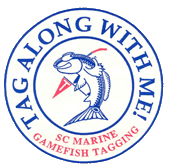SC Marine Game Fish Tagging Program
Goal:
The goal of the marine game fish tagging program is to improve the ability of recreational anglers to recognize and understand the impacts their actions have towards marine resource conservation and management.
Objectives:
Through participation in a volunteer tagging program recreational anglers will:
- Learn to practice effective techniques in the proper handling and releasing of marine gamefish.
- Recognize the benefits of practicing catch and release through the short and long term recovery of tagged marine fish.
- Develop an appreciation for South Carolina’s marine resources and actively promote the stewardship of those resources.
- Provide scientists with accurate information regarding recreational fishing activity that can be utilized in fishery management applications.
Program Summary:
The South Carolina Marine Game Fish Tagging Program (MGFTP) began in 1974 and was the first state sponsored public tagging program on the East Coast. The program was initiated with a small contribution from the Charleston based South Carolina Saltwater Sportfishing Association. For a number of years the program received funding from the U.S. Fish and Wildlife Service’s Sport fish Restoration Act before coming under the funding umbrella of the South Carolina Saltwater Recreational Fishing License. The tagging program has proven to be a useful tool for promoting the conservation of marine game fish and increasing public resource awareness. In addition, the program has provided biologists with valuable data on movement and migration rates between stocks, growth rates, habitat utilization, and mortality associated with both fishing and natural events.
Since its inception, nearly 9,000 participants comprised of South Carolina recreational anglers, charterboat captains, headboat captains, and commercial fishermen have tagged and released over 134,000 marine finfish. Marine finfish species are identified for tag and release based on their importance both recreationally and commercially to the State and South Atlantic region. The program maintains a list of around 46 target species representing 20 families. The list of target species has been periodically modified throughout the life of the program in order to address data needs related to seasonal movements, habitat requirements, growth rates, and release mortality. By far, red drum has comprised the majority (about 46%) of the fish tagged in this program, with non-target species making up less than 3% of the total fish tagged and released. The popularity of red drum as a target species for tag and release often lead to the misunderstanding that the MGFTP’s primary focus was on red drum, when in fact the program has always been a multi-species tagging program.
The SCDNR Marine Game Fish Tagging Program utilizes two types of tags, each of which has proven to have good tag retention and is relatively easy to apply. T-bar anchor tags that are applied using the Dennison Standard Soft Grip Tagging Gun (Model D16000) and nylon dart tags that are applied using a tagging applicator. T-bar anchor tags are supplied to anglers in strips of 25 along with a data sheet for recording the initial tag information. Nylon dart tags along with an applicator (if needed) come as a kit that includes 10 tags along with corresponding tag cards.
Anglers who recapture a tagged fish are asked to report the recapture as soon as possible. The tag number, which is printed both at the base of the yellow streamer (above barb) and close to the end, should be recorded along with the mailing address. If possible, leave the tag intact. However, if there is no means of recording the tag number at the time of capture, clip off the tag number closest to the end leaving the rest of the tag intact and mail to the address printed on the streamer. Along with the tag number, the angler should give his or her name and address, the location and date of the recapture, and a measurement of the fish. In order for biologists to determine growth rate, an accurate measurement is important. The length measurement, which is a better indicator of fish size than weight, should be taken from the tip of the lower jaw to the tip of the tail. Any other information regarding the condition of the fish is also helpful.
In appreciation for reporting a tag recapture anglers receive a T-shirt or hat and both the angler who tagged the fish and the angler who reported the recapture receive a report that gives the history of the fish. Included in the report are the date, location, size, and angler who originally tagged the fish as well as equivalent information on the recapture.
